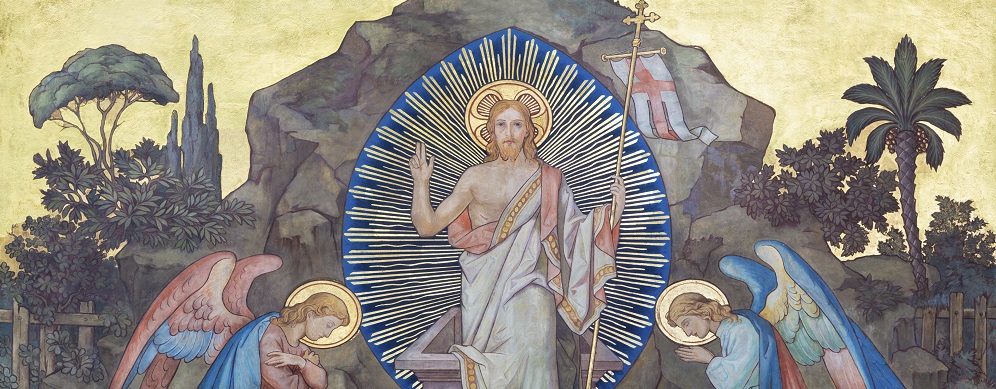Easter Sunday is the Church’s greatest feast day — a day in which we celebrate Jesus Christ’s Resurrection from the dead. It is the “Feast of feasts” and the “Solemnity of solemnities.” The Catechism of the Catholic Church states: “Beginning with the Easter Triduum as its source of light, the new age of the Resurrection fills the whole liturgical year with its brilliance” (No. 1168). Christians believe that Jesus “crushed death,” and the “mystery of the Resurrection … permeates with its powerful energy our old time, until all is subjected to him (CCC, No. 1169).
Jesus Christ truly died on Good Friday. There was no mistaken prognosis that Jesus did not really expire on the cross; there was no accidentally identifying Jesus as someone else. There was no theft of Jesus’ body from the tomb; no swallowing up of the body in an earthquake. From the beginning, Christians proclaimed not only the resurrection of Jesus, but also his very real death. His human soul separated from his human body. All of the gospels testify to this. Without that death, his appearances to the women and to his apostles on Easter morning would have been humdrum. Instead, people were terrified, overjoyed and astonished.
There are factors that confirm the Church in her faith in the resurrection of Jesus. First is the empty tomb. The apostles saw the empty tomb and heard the testimony of the women who went there on the first Easter morning: “…[T]he empty tomb was…an essential sign for all. Its discovery by the disciples was the first step toward recognizing the very fact of the Resurrection.” (CCC, No. 640).
Second, the apostles saw Jesus with their own eyes. They disbelieved at first — and who wouldn’t? — but were convinced by the fact that they could touch him, speak to him and eat with him. Jesus’ body was clearly different than it was before, and almost always the women, the apostles and the disciples do not recognize him at first. Each time, however, Jesus reveals himself to them, and they are able to make the connection that this one standing before them was the same one who died by crucifixion on Good Friday. In the encounter with the apostle Thomas, Jesus actually points to his wounds as the way for Thomas to make the connection that the man standing before him, talking and breathing, is the same man who was crucified. Jesus had to lead Thomas and the others to that understanding, because his glorified and risen body was no longer subject to the limitations of space and time. He could appear as he wished, when he wished. He could be in their presence and not reveal himself, and then allow them to recognize him in an instant. All of this has to do with his glorified, risen humanity and its new properties. “At Jesus’ Resurrection his body is filled with the power of the Holy Spirit: he shares the divine life in his glorious state, so that St. Paul can say that Christ is ‘the man of heaven’” (CCC, No. 646).
The Resurrection also brought St. Paul, who hated Christians, to believe in Christ and to be baptized in Damascus, after having encountered him on the road there. He saw him with his own eyes. He heard his voice. He spoke to him. Later, in his letter to the Galatians, Paul had to compare his authority to preach the gospel as being on par with that of the first apostles, and so he based his valid apostleship on his encounter with the risen Jesus. He himself saw the Lord Jesus risen from the dead, and from that encounter, Paul’s life was transformed, and he became God’s apostle.
It was the fact of the resurrection that compelled the apostles to preach that Jesus was and always will be the true messiah and the savior of the world. It is still the Resurrection of the Lord Jesus that compels Christians to share his life and message and to dedicate their lives to him. Without the resurrection, Paul says, Christianity is useless: “For if the dead are not raised, then Christ has not been raised. If Christ has not been raised, your faith is futile and you are still in your sins” (1 Cor 15: 16-17). He continues: “But in fact Christ has been raised from the dead, the first fruits of those who have fallen asleep. For as by a man came death, by a man has come also the resurrection of the dead. For as in Adam all die, so also in Christ shall all be made alive” (v. 20-22).
Because of the evidence of the empty tomb and the encounters of the risen Jesus with the women, the apostles and disciples, and St. Paul, the Church has always believed and preached the resurrection of Jesus from the dead. It is the moment that definitively changed human history forever. Jesus’ rising from the dead was the catalyst for all evangelization, meaning the fact of Jesus’ resurrection impelled the apostles to go and tell people what had happened. That is still what the Church proclaims today, and she always will.
Sister Anna Marie McGuan, RSM, is director of Christian formation in the Diocese of Knoxville.

